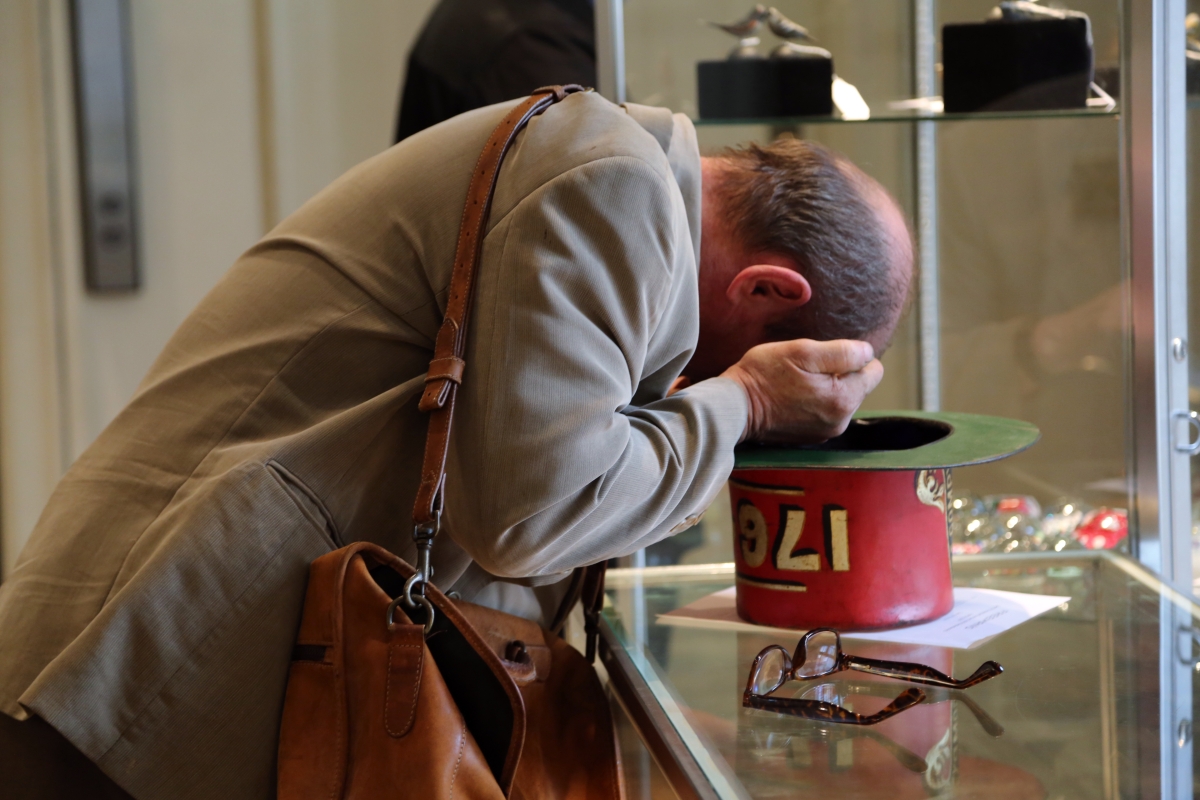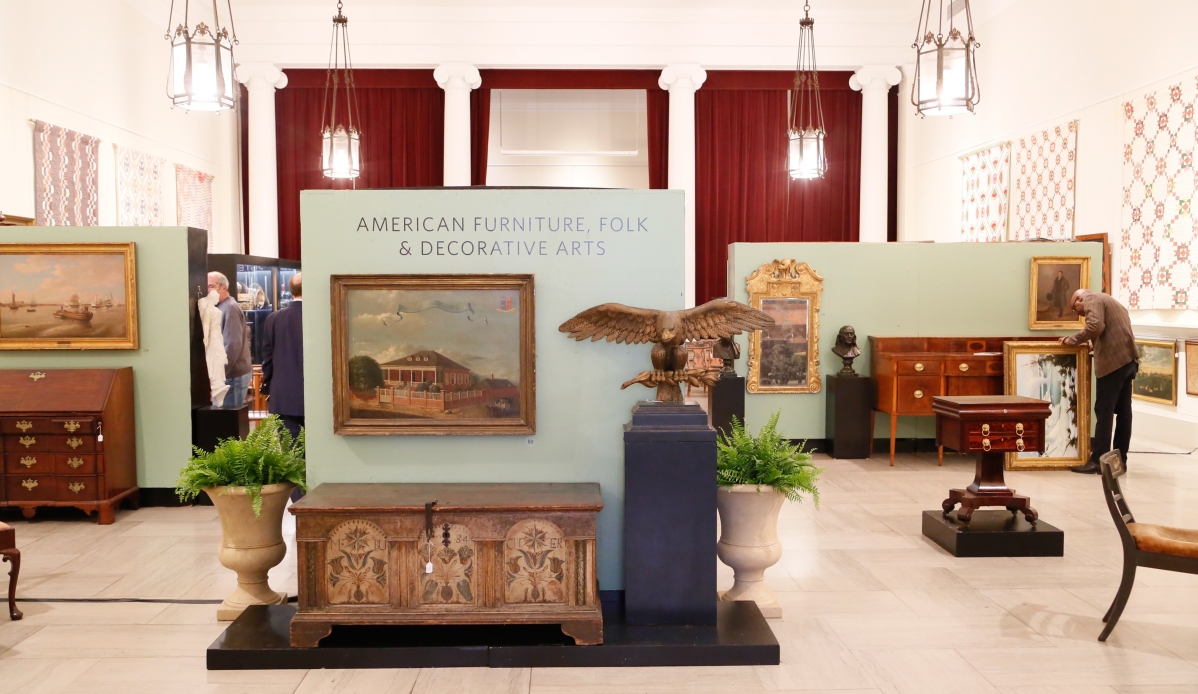
The exhibition room in Freeman’s historic 200-year-old gallery on Chestnut Street provides an apt backdrop for early American fine art and decorative arts.
Review and Onsite Photos by Greg Smith, Catalog Photos Courtesy Freeman’s Auction
PHILADELPHIA, PENN. – Right on the heels of the Philadelphia Antiques & Art Show, Freeman’s American furniture, folk and decorative arts sale found a bid list of committed interest from buyers as they stretched out and basked in a city of plush and opportune offerings that were up for grabs. “It was a tiny sale,” said Lynda Cain, vice president and department head at Freeman’s, but that did not deter interest as the 239 lots went out with an impressive sell-through rate of 85 percent and tallied $810,000 in total sales. The auction saw institutions and private, trade and corporate bidders competing on a selection of choice lots from estates up and down the East coast.
“I didn’t recognize a number of people,” said Cain. “We had an influx of new bidders and people who were traveling to the show who took the opportunity to come see the auction.”
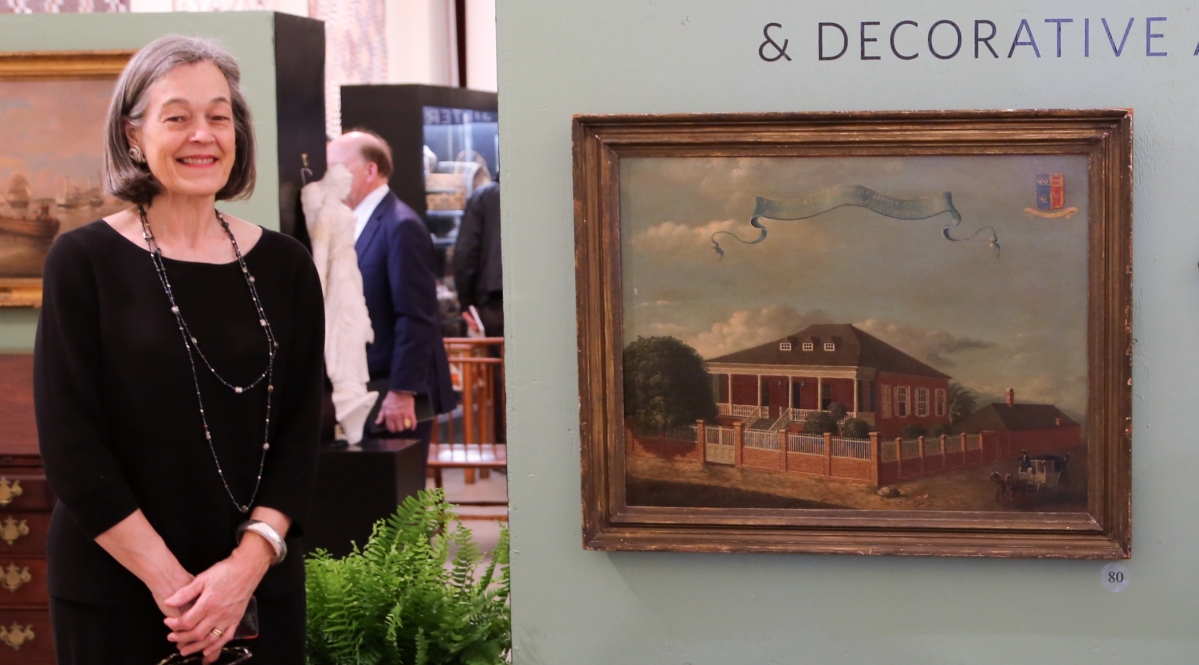
Lynda Cain, vice president and department head for the American furniture, folk and decorative arts department, stands with the top lot of the day, a Samuel Felsted 1778 oil on canvas painting depicting a planter’s house in Jamaica. Felsted was a multidisciplinary artist with ties to Philadelphia, having been inducted in the Philadelphia-based American Philosophical Society in 1771. The painting found interest across the board, finally settling at $100,000 to a bidder from the trade.
Booming above all other lots in the sale was an oil painting by Jamaican-born artist Samuel Felsted, depicting a view of a brick house that belonged to Emanuel Lousada, a Jewish merchant in Kingston. The painting finally settled down at $100,000 after a bidding match between private collectors, trade and institutions, with trade winning out. Felsted was one of only four Jamaicans to be admitted to the American Philosophical Society in Philadelphia in the Eighteenth Century and is better known today as the composer of “Jonah,” the first complete oratorio written in the New World, published in 1775. The painting featured Lousada’s home from the northeast view, gated and surrounded by a brick wall, blue skies above and a horse and carriage waiting outside. Lousada’s coat of arms appears in the top right corner.
“The painting depicted all the embodiments of status,” said Cain. “It’s amazing to have a depiction of a planter’s house at this time. The scholarship on the colonial experience includes the West Indies and the Caribbean, you can’t isolate them.”
The second highest lot was another artwork, this one a portrait of Nineteenth Century Massachusetts Congressman Daniel Webster, painted by Gilbert Stuart. It brought $75,000 from a private collector. The painting was originally commissioned by Isaac P. Davis, a wealthy manufacturer of cables and cordage used in the construction of rope bridges in the Boston area. Davis was a good friend of both Stuart and Webster and would later gift the painting to the sitter. Davis was a patron of the arts, serving on the Fine Arts Committee of the Boston Athenaeum for some time.
Finishing at $68,750 was a Philadelphia Chippendale case clock from David Rittenhouse. The walnut example dated to 1775 with engraving on the single-sheet dial attributed to James Smither. It sold to an unnamed institution.
Among other furniture lots was a circa 1800 Federal inlaid mahogany stage-top sideboard. The example had descended through the Heriot-Sparkman family in Charleston, S.C., and will return to the area in the hands of the new owner, who won the lot for $22,500.
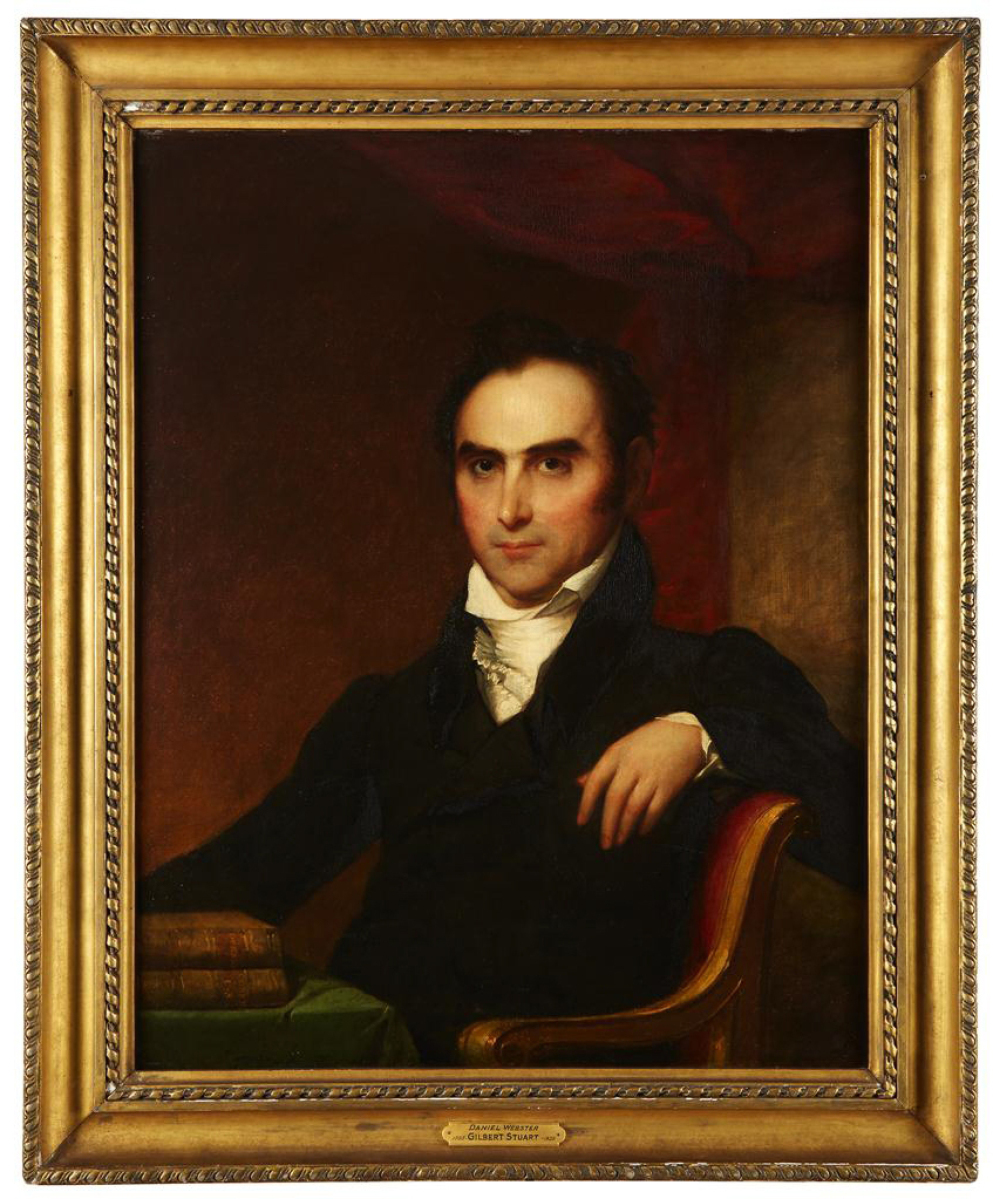
This painting of Massachusetts Congressman Daniel Webster was the second highest lot of the day at $75,000. It was originally commissioned by Isaac P. Davis from painter Gilbert Stuart; all three were friends. Davis was a patron of the Boston Athenaeum for quite some time, serving on the Fine Arts Committee.
A Lancaster County, Penn., painted architectural blanket chest, dated 1784, featured six-pointed stars over pots of flowers. That motif was employed by several decorators in Lancaster County during this period, according to Monroe H. Fabian in The Pennsylvania-German Decorated Chest. It sold for $13,750, just above high estimate.
A notable collection of pristine quilts and coverlets with near-perfectly preserved color came from the estate of Elizabeth Farris Hulcher. In 1979, more than 50 quilts and coverlets dating from 1830 to 1910 were discovered in the attic of Mattie Duncan Beard in Jonesboro, Tenn. While some were auctioned off at the time, the 18 lots offered in Freeman’s sale descended through the family to Hulcher, who began research into their origin. Hulcher’s determination brought her in contact with conservators and curators who, along with the family’s oral tradition, helped place the makers with the McLin family women, who were known as “the finest seamstresses in the area.” The collection went on to be featured in publications and exhibited in numerous museums.
“I was delighted with the kind of interest that we had in the quilts,” said Cain. “With the exception of a few examples, pieced quilts have not been bringing what they once did. With this collection, we had interest from collectors, museums and even corporations, which I hadn’t seen in a while. I think people were simply astounded by the number of quilts that came from one family.”
At the helm of the group was a pieced Morning Sun or New York Beauty patterned quilt in green and red on a white background. It dated to 1850-60 and brought $4,375. Another identically colored example with a slightly different pattern brought the same. The next highest was a lot that came with two quilts, a pieced Sunburst or Rising Sun patterned quilt and Snowball patterned example. The duo sold for $3,750.
Fifty-one lots of American Indian arts were consigned by the Sisters of the Blessed Sacrament, a religious order founded by Katharine Drexel in 1891. That name should sound familiar; the Drexel family was one of the wealthiest in Philadelphia at the turn of the Nineteenth Century. Katharine’s father was Francis Anthony Drexel, a business partner of J.P. Morgan, along with his brother Anthony Joseph Drexel Sr, who also founded Drexel University.
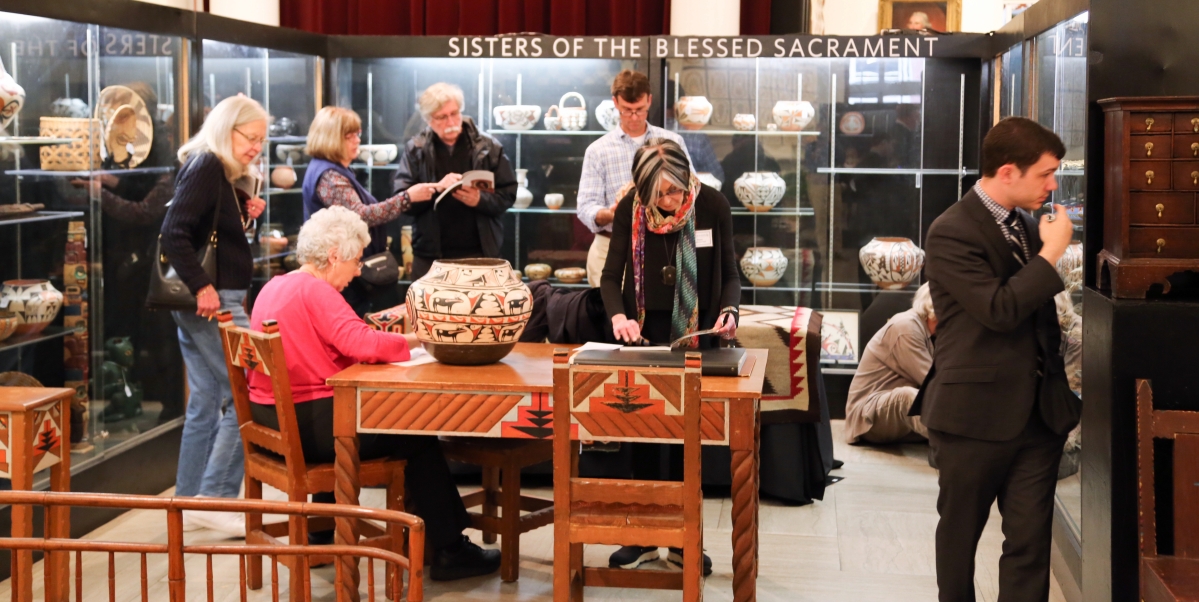
Walking into the exhibition room the weekend before the sale, previewers were drawn to the American Indian lots from the collection of the Sisters of the Blessed Sacrament.
The Sisters of the Blessed Sacrament was established by Katharine Drexel to specifically aid African Americans and Native Americans against the deprivations that were carried out against them at the time. Based out of a 44-acre property in Bensalem, Penn., the order went on to build 145 missions, 45 elementary schools, 12 high schools and a university. Katharine Drexel was ultimately canonized as a saint in 2000 and the Bensalem property came to be known as the National Shrine of Saint Katharine Drexel.
A result of Drexel’s unyielding promotion of the arts and culture, the American Indian lots offered from this collection represented the Hopi, Navajo, Pueblo and Sioux tribes. The lots included pottery, beadwork, weavings, basketry, ritual pieces, textiles, dolls, works on paper and more. Among the highlights was a Twentieth Century Navajo dazzler wool rug, 44 by 71 inches, in red, cream, navy, teal, orange and brown. It brought $4,688. A 12þ-inch San Ildefonso blackware pottery vase by Marie and Julian Martinez finished at $4,063, while a 13-5/8-inch-diameter plate from the same makers went for $3,750. A graphically stunning group of 11 works on paper by various artists included gouaches, inks on paper and silkscreens as it rode bidding to $3,770, well above the $600 high estimate.
As “The Good Gray Poet” Walt Whitman continues his eternal march through our collective conscience, memorabilia and objects surrounding his life continue to find interest among his admirers and collectors. A pair of gold memento rings, each containing a small lock of Whitman’s hair, offered together with a carte-de-visite from 1878 depicting the poet with two children, climbed the paddles to $20,000, high above the $5,000 estimate. The children shown with Whitman were Kitty and Harry Johnston, who were both well acquainted with “Uncle Walt,” as they called him, through their parents, New York jeweler John Henry Johnston and his wife, Amelia F. Johnston. According to the Walt Whitman Archives, Johnston “provided personal and financial support for the aging poet and housed him for long stays in New York in the 1870s.”
From a Philadelphia collection came one of the most graphic objects in the sale: a painted and decorated leather and felt parade hat for the Franklin Fire Company. It dated to 1840-60 from Germantown, Penn., and featured a polychromed portrait of Benjamin Franklin within a bannerette reading “Franklin Fire Compy,” gold embellishments all around on a red painted hat form. Franklin was an apt subject for the firehouse as he was associated with the founding of Philadelphia’s firefighting and insurance companies. It sold for $18,750.
A block of ten lots were reserved for small, painted birds from A. Elmer Crowell. The examples included a Nashville warbler, a nuthatch, a cedar waxwing, a red-headed woodpecker, a towhee and a robin, among others. Each sat on a painted half-circle stand, some looking down while others peered off. While they were all in standing position, they all seemed to be busy and anxious, flighty, if you will, by bird standards. The woodpecker brought $1,125, while a few other lots sold for $875 or did not find a buyer.
All prices reported include the buyer’s premium.
Freeman’s Auction is at 1808 Chestnut Street. For information, www.freemansauction.com or 215-563-9275.

